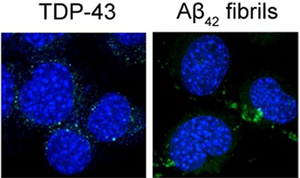
Researchers from the University of Florence investigated the nature of TAR DNA-binding protein 43 (TDP-43) cytoplasmic inclusions, which are key pathological markers in neurodegenerative diseases like amyotrophic lateral sclerosis (ALS) and frontotemporal lobar degeneration (FTLD). The study focused on whether these inclusions exhibit amyloid-like characteristics, as there has been debate over their structure and classification.
The researchers conducted in situ and in vitro experiments to study TDP-43 inclusions. They expressed human TDP-43 in a motor neuron cell model and used Raman spectroscopy, FTIR, and TEM to examine aggregate structures. Purified TDP-43 was tested for amyloid formation using Amytracker 630.
The findings suggest that TDP-43 inclusions do not have amyloid characteristics, challenging the idea that they form amyloid-like structures. Instead, they likely form through a different mechanism.
Image: Amytracker 630 was used to stain β fibrils, but it did not stain the cytoplasmic inclusions of TDP-43. Image from Figure 2 by Cascella, R. et al. (2023) Annals of Medicine, 55(1), 72-88 (CC BY 4.0).
